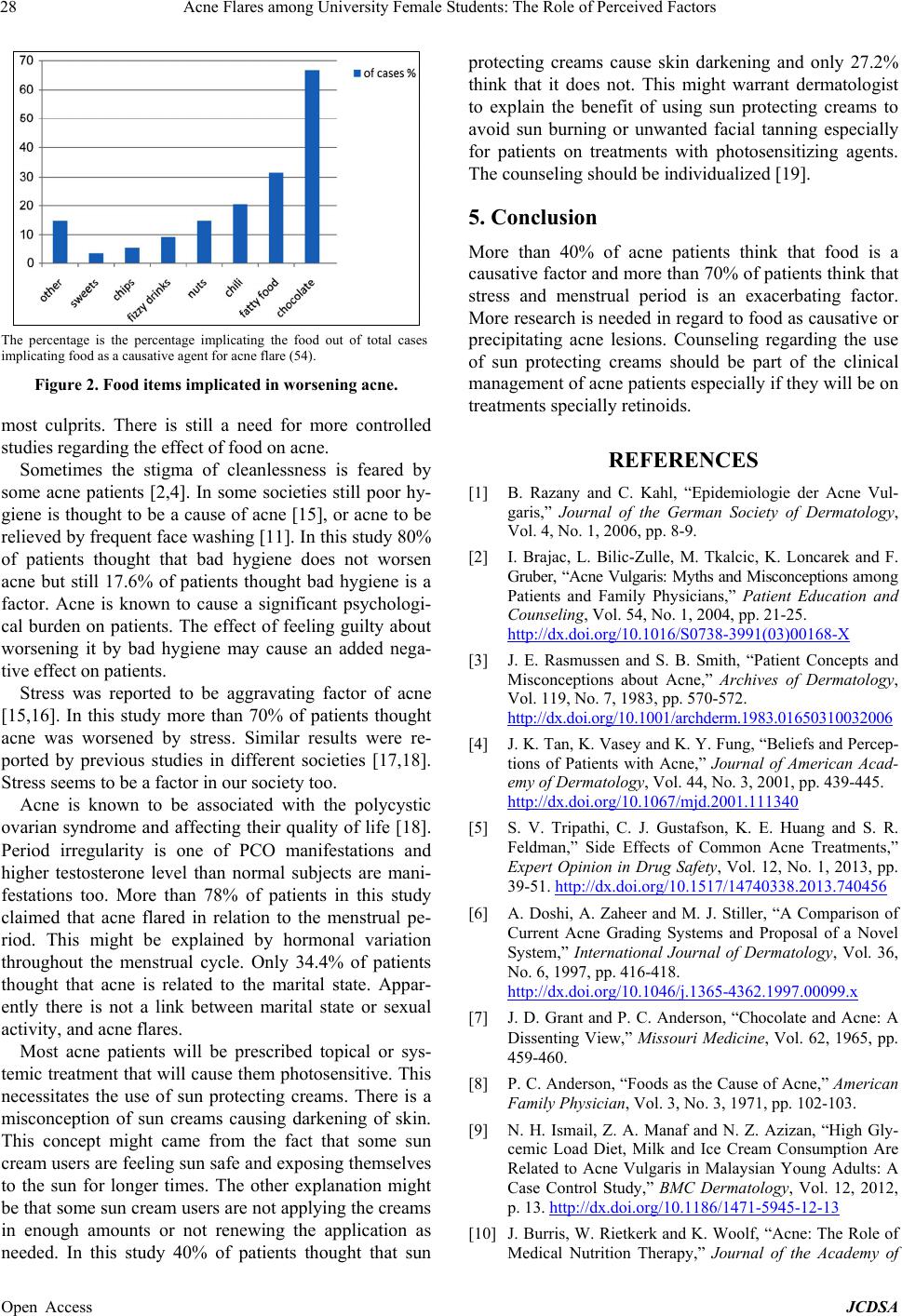
Acne Flares among University Female Students: The Role of Perceived Factors
28
The percentage is the percentage implicating the food out of total cases
implicating food as a causative agent for acne flare (54).
Figure 2. Food items implicated in worsening acne.
most culprits. There is still a need for more controlled
studies regarding the effect of food on acne.
Sometimes the stigma of cleanlessness is feared by
some acne patients [2,4]. In some societies still poor hy-
giene is thought to be a cause of acne [15], or acne to be
relieved by frequent face washing [11]. In this study 80%
of patients thought that bad hygiene does not worsen
acne but still 17.6% of patients thought bad hygiene is a
factor. Acne is known to cause a significant psychologi-
cal burden on patients. The effect of feeling guilty about
worsening it by bad hygiene may cause an added nega-
tive effect on patients.
Stress was reported to be aggravating factor of acne
[15,16]. In this study more than 70% of patients thought
acne was worsened by stress. Similar results were re-
ported by previous studies in different societies [17,18].
Stress seems to be a factor in our society too.
Acne is known to be associated with the polycystic
ovarian syndrome and affecting their quality of life [18].
Period irregularity is one of PCO manifestations and
higher testosterone level than normal subjects are mani-
festations too. More than 78% of patients in this study
claimed that acne flared in relation to the menstrual pe-
riod. This might be explained by hormonal variation
throughout the menstrual cycle. Only 34.4% of patients
thought that acne is related to the marital state. Appar-
ently there is not a link between marital state or sexual
activity, and acne flares.
Most acne patients will be prescribed topical or sys-
temic treatment that will cause them photosensitive. This
necessitates the use of sun protecting creams. There is a
misconception of sun creams causing darkening of skin.
This concept might came from the fact that some sun
cream users are feeling sun safe and exposing themselves
to the sun for longer times. The other explanation might
be that some sun cream users are not applying the creams
in enough amounts or not renewing the application as
needed. In this study 40% of patients thought that sun
protecting creams cause skin darkening and only 27.2%
think that it does not. This might warrant dermatologist
to explain the benefit of using sun protecting creams to
avoid sun burning or unwanted facial tanning especially
for patients on treatments with photosensitizing agents.
The counseling should be individualized [19].
5. Conclusion
More than 40% of acne patients think that food is a
causative factor and more than 70% of patients think that
stress and menstrual period is an exacerbating factor.
More research is needed in regard to food as causative or
precipitating acne lesions. Counseling regarding the use
of sun protecting creams should be part of the clinical
management of acne patients especially if they will be on
treatments specially retinoids.
REFERENCES
[1] B. Razany and C. Kahl, “Epidemiologie der Acne Vul-
garis,” Journal of the German Society of Dermatology,
Vol. 4, No. 1, 2006, pp. 8-9.
[2] I. Brajac, L. Bilic-Zulle, M. Tkalcic, K. Loncarek and F.
Gruber, “Acne Vulgaris: Myths and Misconceptions among
Patients and Family Physicians,” Patient Education and
Counseling, Vol. 54, No. 1, 2004, pp. 21-25.
http://dx.doi.org/10.1016/S0738-3991(03)00168-X
[3] J. E. Rasmussen and S. B. Smith, “Patient Concepts and
Misconceptions about Acne,” Archives of Dermatology,
Vol. 119, No. 7, 1983, pp. 570-572.
http://dx.doi.org/10.1001/archderm.1983.01650310032006
[4] J. K. Tan, K. Vasey and K. Y. Fung, “Beliefs and Percep-
tions of Patients with Acne,” Journal of American Acad-
emy of Dermatology, Vol. 44, No. 3, 2001, pp. 439-445.
http://dx.doi.org/10.1067/mjd.2001.111340
[5] S. V. Tripathi, C. J. Gustafson, K. E. Huang and S. R.
Feldman,” Side Effects of Common Acne Treatments,”
Expert Opinion in Drug Safety, Vol. 12, No. 1, 2013, pp.
39-51. http://dx.doi.org/10.1517/14740338.2013.740456
[6] A. Doshi, A. Zaheer and M. J. Stiller, “A Comparison of
Current Acne Grading Systems and Proposal of a Novel
System,” International Journal of Dermatology, Vol. 36,
No. 6, 1997, pp. 416-418.
http://dx.doi.org/10.1046/j.1365-4362.1997.00099.x
[7] J. D. Grant and P. C. Anderson, “Chocolate and Acne: A
Dissenting View,” Missouri Medicine, Vol. 62, 1965, pp.
459-460.
[8] P. C. Anderson, “Foods as the Cause of Acne,” American
Family Physician, Vol. 3, No. 3, 1971, pp. 102-103.
[9] N. H. Ismail, Z. A. Manaf and N. Z. Azizan, “High Gly-
cemic Load Diet, Milk and Ice Cream Consumption Are
Related to Acne Vulgaris in Malaysian Young Adults: A
Case Control Study,” BMC Dermatology, Vol. 12, 2012,
p. 13. http://dx.doi.org/10.1186/1471-5945-12-13
[10] J. Burris, W. Rietkerk and K. Woolf, “Acne: The Role of
Medical Nutrition Therapy,” Journal of the Academy of
Open Access JCDSA